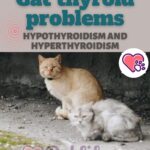
Muscle pains in cats can have different origins and treatments depending on the case: here are what they are and how to raise the problem of our feline friends.
We always see them moving sinuously with elegant shots and leaps that make humans hold their breath. In short, the cat has an enviable agility and ability to move: but what is their secret? It’s all in the system of muscles and bones that distinguish their morphology. But when the perfect mechanism of their physique gets jammed, problems with the muscular system begin. Here are the main pathologies that afflict them and what are the recommended remedies.
The muscular and bone system of the cat
The cat’s body allows it to move and shoot unthinkable for the human body: it is a very articulated and complex structure, but which gives truly surprising results. A bone structure of 240 bones, connected not only by ligaments, as in humans, but also by 500 muscles contributes to its good functioning. They do not have a collarbone, so the shoulder opens easily: it is no coincidence that it is also called the ‘flying shoulder’. To complete this fantastic bone-muscular system is the spine that allows them 360˚ movements.
Gait of the cat: the muscular system that supports it
Given the extreme mobility of the bones, there is a precise dynamics at the base of the sinuous and snappy gait of the cat: the hind legs give the push and the front ones act as a ‘stop’. Even in jumps, the cat is able to calculate how much propulsive force it must put into its hind legs to give itself momentum, but in the case of a jump due to a sudden fear, all four legs are activated at the same time. Let’s not forget that the cat walks leaning on the tips of the fingers: this allows them to run very quickly since the friction with the ground is less.
The three types of muscles in the cat
The feline muscular system is made up of three types of muscles, all made of fibers held together by connective tissue. The first type is the cardiac type, which is found only in the heart; the second, also called smooth or non-striated, which controls the internal organs and a third type, called striatum, which includes the muscles under the control of the nervous system. The muscle cells that form muscles are divided into as many types: fast-twitch that fatigue, fast-twitch resistant to fatigue and slow-twitch cells. The first type makes up most of the muscles that are activated very quickly but get tired just as easily (so much so that a cat is able to jump suddenly, but gets tired immediately after the effort). The second type highlights another characteristic of the cat’s muscles: the lack of resistance is due to the fact that there are few fatigue-resistant cells. Finally, the slow-twitch cells work slowly and tire just as slowly: the cat activates them when it has to hide or reach its prey stealthily, without being seen.
Muscle pathologies in cats
Before focusing on the main diseases that can afflict the muscular system of our cat, a small introduction is necessary on the muscular contraction system of the feline. The contraction, or action-against, is the response to the consumption of energy necessary to carry out an effort: this force is released through ATP, abbreviation for ‘adenosine-triphosphate’, occurs only in the presence of calcium and magnesium. A buildup of lactic acid, produced by ATP stores, causes cramps. The examination of the electromyographyallows you to evaluate the state of the electrical activity of the feline muscle: it is the equivalent of our electrocardiogram for the human heart. If the muscle does not have a regular activity, and therefore a malfunction, we are in the presence of a reduction in muscle tone also called ‘atrophy’. In this case the nerve becomes paralyzed and interrupts the ‘communication’ with the muscle, which consequently does not move. But this is only one of the cat’s muscular problems, which we are now going to evaluate specifically. Among the most important, and alas most frequent, pathologies of cats are myositis, fatigue myopathies and hereditary myopathies. The group of pathologies also closes: myotonia congenita, feline Polymyositis and tumor lesionswhich, however, are much rarer and more typical of older cats.
Muscle atrophy
Failure of the muscles, caused by nerve paralysis, is at the root of the atrophy. It can only be temporary, i.e. a consequence of a surgical operation and its subsequent immobilization of the affected part: in this case a few motor rehabilitation sessions will be enough to reactivate the muscle. But atrophy can also have other origins, much more worrying: systemic diseases, such as Leishmaniasis (temporal muscle atrophy) or Cushing’s Syndrome (abdominal muscle atrophy), although this are among the most frequent diseases in dogs.
Myositis in cats
The term ‘myositis’ indicates a musculoskeletal disease, which causes damage to muscles or muscle tissues. Its origin can be congenital, and therefore present from birth or caused by nutritional deficiencies, injuries or intoxications. By inflaming the muscles, myositis causes limited mobility, continuous muscle spasms and a general state of fatigue and lethargy. If the muscles become inflamed, the cat cannot move well, so it freezes to avoid pain. Sometimes the inflammation is visible to the naked eye as it creates red spots on the skin: this problem can be alleviated with cold packs and anti-inflammatories prescribed by the veterinarian. Furthermore, myositis can be at the basis of involuntary muscle movements or spasms, but only when the disease is in an advanced state.
Remedies for myositis
In addition to cold water packs and anti-inflammatories, it is advisable to always have water to drink at hand for our cat: dehydration could worsen his condition and lead to further complications. The feline’s bed must also be soft and quiet to relieve its pains. In addition to drug treatment, physical activity is also useful, which includes some exercises to limit muscle stiffness and improve flexibility. The general sense of exhaustion can also cause loss of appetite: let’s try to stimulate his appetite with the baby food he likes best! However, it is important that they are soft and easy to digest foods, and in small portions.
Myopathies in cats
The term ‘myopathy’ indicates a muscle disease that involves muscle weakness, which is congenital in some breeds such as the Devon Rex and the Sphynx. Scientifically speaking, it is a mutation that affects the COLQ gene and causes congenital myasthenic syndrome, similar to that which affects humans or fatigue. A cat with myopathy has very visible symptoms: a flexion of the neck and head as well as a swaying pattern of the upper body, the most exposed shoulder blade, and a general sense of muscle weakness and fatigue. In the case of fatigue myopathy these symptoms can be more evident after an effort, a stressful or exciting activity: they tire easily and often tend to rest by placing their front legs on a comfortable support, such as a pillow.
Myotonia congenita
Although counted among the muscular dystrophies, myotonia congenita is not progressive, so the symptoms do not tend to worsen but remain stable (the stabilization time varies between 6 and 12 months of age of the feline). It is an annoying and painful disease, but not fatal: in fact, life expectations are quite positive in the majority of cases. At a muscular level it involves prolonged contraction of the muscles when they stop, that is after a voluntary movement: in other words after the effort, the cat cannot easily relax the muscle, which therefore does not relax. Scientifically, the cause should be found in poor chlorine circulation: the muscle membrane is in hyper-excitation. A rare form of congenital myotonia may occur in the cat, with phenomena of dysphonia (linked to the emission of cries and sounds, with hoarse meowing) and dysphagia (difficulty in ingesting food and the feeling that they remain stuck halfway between the mouth and stomach) . Both disorders cause coughing, retching and other breathing problems, caused by the continuous contraction of the muscles of the affected parts.
The feline Polymyositis
Polymyositis, indicated by the abbreviation PM, is a disorder that inflames the skeletal muscles and the connective tissue that binds them. It involves a general sense of weakness in the extreme muscles of the body, namely those of the neck and pharynx. Scientifically it involves a high level of muscle enzymes and its diagnosis takes place through the examination of the electromyogram but also with a muscle biopsy.
Tumor lesions in cats

In the various types of muscle cancer that afflict our feline friends we find, in the first place, oral squamous carcinoma. It has characteristics similar to that of humans and is also nicknamed ‘fibrosarcoma or soft tissue sarcoma’: it is a tumor that develops in the muscle or connective tissue of the body. Unfortunately, the pathology can have different diagnoses and therapies, depending on the severity of the specific case: most of the time the expert recommends combining the surgery with radiotherapy and chemotherapy sessions. Even the outcome of these treatments can give very different results and consequently life expectations can also be very different from case to case.






